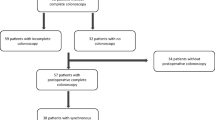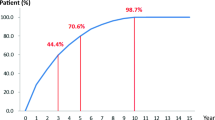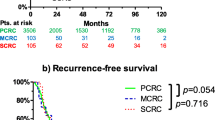Abstract
PURPOSE: We evaluated the accuracy of preoperative diagnostic examinations and determined whether patients with synchronous colorectal cancers differ from patients with a single colorectal malignancy in clinicopathologic factors, the possibility of early metachronous colorectal cancer, and postoperative outcome. METHODS: A retrospective evaluation of 1,780 patients with primary colorectal adenocarcinoma from 1987 to 1993 was performed. We divided patients into three groups: Group 1, single colorectal adenocarcinoma; Group 2, synchronous colorectal adenocarcinoma; and Group 3, early metachronous colorectal adenocarcinoma. RESULTS: There were 52 cases (3 percent) in Group 2 and 13 cases (1 percent) in Group 3 (<3 years from the index colorectal cancer operation). Differences in age, gender, and cancer-free rate among the three groups did not reached statistical significance. Compared with cancers in Group 1, significantly more proximal tumor locations and early cancer stage were noted for the second and third cancers in Group 2. In Group 3 a significantly more proximal tumor site was noted for the index colorectal cancer but cancer stage showed no significant difference from cancers in Group 1. Better histologic type was also noted in the index and second cancers in Group 2 than in cancers in Group 1. There was a higher incidence of associated benign adenoma in Group 2 (35vs. 15 percent in Group 1). The positivity rate of Group 2 was significantly higher by preoperative colonoscopy (71 percent) and incidental findings at surgery (58 percent) than barium enema examination (30 percent). CONCLUSION: Preoperative barium enema examination was an unsatisfactory tool for detecting synchronous tumors. Preoperative colonoscopy demonstrated a higher positivity rate, but it still failed to detect nearly 30 percent of cases with synchronous tumors. Intraoperative palpation of the whole colorectum could detect nearly 60 percent of unexpected synchronous tumors. We believe both colonoscopy and intraoperative palpation of the whole colorectum are crucial to the early detection of synchronous colorectal cancer.
Similar content being viewed by others
References
Billroth I. Die allegemeine Chirugische Pathologie und Therapie. Berlin: Reisner, 1889:908.
Czerny LL. Aus der Heidelberger Chirurgischen Klinik. Nochtrag zur Darmresection. Berl Klin Woschr 1880;17:683.
Fenger C. Double carcinoma of the colon. JAMA 1888;11:606–8.
Takeuchi H, Toda T, Nagasaki S,et al. Synchronous multiple colorectal adenocarcinomas. J Surg Oncol 1997;64:304–7.
Finan PJ, Ritchie JK, Hawley PR. Synchronous, and “early” metachronous carcinomas of the colon and rectum. Br J Surg 1987;74:945–7.
Kune GA, Kune S, Watson LF. History of colorectal polypectomy and risk of subsequent colorectal cancer. Br J Surg 1987;74:1064–5.
Heald RJ, Lockhart-Mummery HE. The lesion of the second cancer of the large bowel. Br J Surg 1972;59:16–9.
Travieso CR Jr, Knoepp LF Jr, Hanley PH. Multiple adenocarcinomas of the colon and rectum. Dis Colon Rectum 1972;15:1–6.
Ekelund GR, Phil B. Multiple carcinomas of the colon and rectum. Cancer 1974;33:1630–4.
Lasser A. Synchronous primary adenocarcinomas of the colon and rectum. Dis Colon Rectum 1978;21:20–2.
Kaibara N, Koga S, Jinnai D. Synchronous and metachronous malignancies of the colon and rectum in Japan with special reference to a co-existing early cancer. Cancer 1984;54:1870–4.
Chu DZ, Giacco G, Martin RG, Guinee VF. The significance of synchronous carcinoma and polyps in the colon and rectum. 1986;57:445–50.
Cunliffe WJ, Hasleton PS, Tweedle DE, Schofield PF. Incidence of synchronous and metachronous colorectal carcinoma. Br J Surg 1984;71:941–3.
Reilly JC, Rusin LC, Theuerkauf FJ. Colonoscopy: its role in cancer of the colon and rectum. Dis Colon Rectum 1982;25:532–8.
Greenstein AJ, Heimann TM, Sachar DB, Slater G, Aufses HS. A comparison of multiple synchronous colorectal cancer in ulcerative colitis, familial polyposis and de novo cancer. Ann Surg 1986;203:123–8.
Tate JJ, Rawlinson J, Royle GT, Brunton FJ, Taylor I. Pre-operative or postoperative colonic examination for synchronous lesions in colorectal cancer. Br. J Surg 1988;75:1016–8.
Muto T, Bussey HJ, Morson BC. The evolution of cancer of the colon and rectum. Cancer 1975;36:2251–70.
Floyd CE, Stirling CT, Cohn I Jr. Cancer of the colon, rectum and anus: review of 1,687 cases. Ann Surg 1966;163:829–37.
Heald RJ, Bussey HJ. Clinical experiences at St Mark's Hospital with multiple synchronous cancers of the colon and rectum. Dis Colon Rectum 1975;18:6–10.
Swinton NW, Parshley PF. Multiple cancers of the colon and rectum. Dis Colon Rectum 1962;5:378–80.
Hancock RJ. Synchronous carcinoma of the colon and rectum. Ann Surg 1975;41:560–3.
Escat J, Gignoux M, Segol P,et al. Cancers multiples-colorectaus. Chirurgie 1985;111:560–4.
Bussey HJ, Wallace MH, Morson BC. Metachronous carcinoma of the large intestine and intestinal polyps. Proc R Soc Med 1967;60:208–10.
Adloff M, Arnaund JP, Bergamaschi R, Schloegel M. Synchronous carcinoma of the colon and rectum: prognostic and therapeutic implications. Am J Surg 1989;157:299–302.
Devitt JE, Roth-Moyo LA, Brown FN. The significance of multiple adenocarcinomas of the colon and rectum. Ann Surg 1968;169:364–7.
Enker WE, Dragacevic S. Multiple carcinoma of the large bowel: a natural experiment in etiology and pathogenesis. Ann Surg 1978;187:8–11.
Copeland EM, Jones RS, Miller LD. Multiple colon neoplasms. Prognostic and therapeutic implications. Arch Surg 1968;98:141–3.
Evers BM, Mullins R, Matthews TH, Broghamer WL, Polk HC Jr. Multiple adenocarcinomas of the colon and rectum. An analysis of incidences and current trends. Dis Colon Rectum 1988;31:518–22.
Bacon HE, Tavenner MC. Multiple primary malignant tumors involving the colon and rectum: report of ninety-four cases. Am J Surg 1952;83:55–63.
Moertel CG, Bargen JA, Dockerty MB. Multiple carcinomas of the large intestine: a review of the literature and a study of 261 cases. Gastroenterology 1958;34:85–98.
Welch JP. Multiple colorectal tumors: an appraisal of natural history and therapeutic options. Am J Surg 1981;42:274–80.
Author information
Authors and Affiliations
About this article
Cite this article
Chen, HS., Sheen-Chen, SM. Synchronous and “early” metachronous colorectal adenocarcinoma. Dis Colon Rectum 43, 1093–1099 (2000). https://doi.org/10.1007/BF02236556
Issue Date:
DOI: https://doi.org/10.1007/BF02236556




